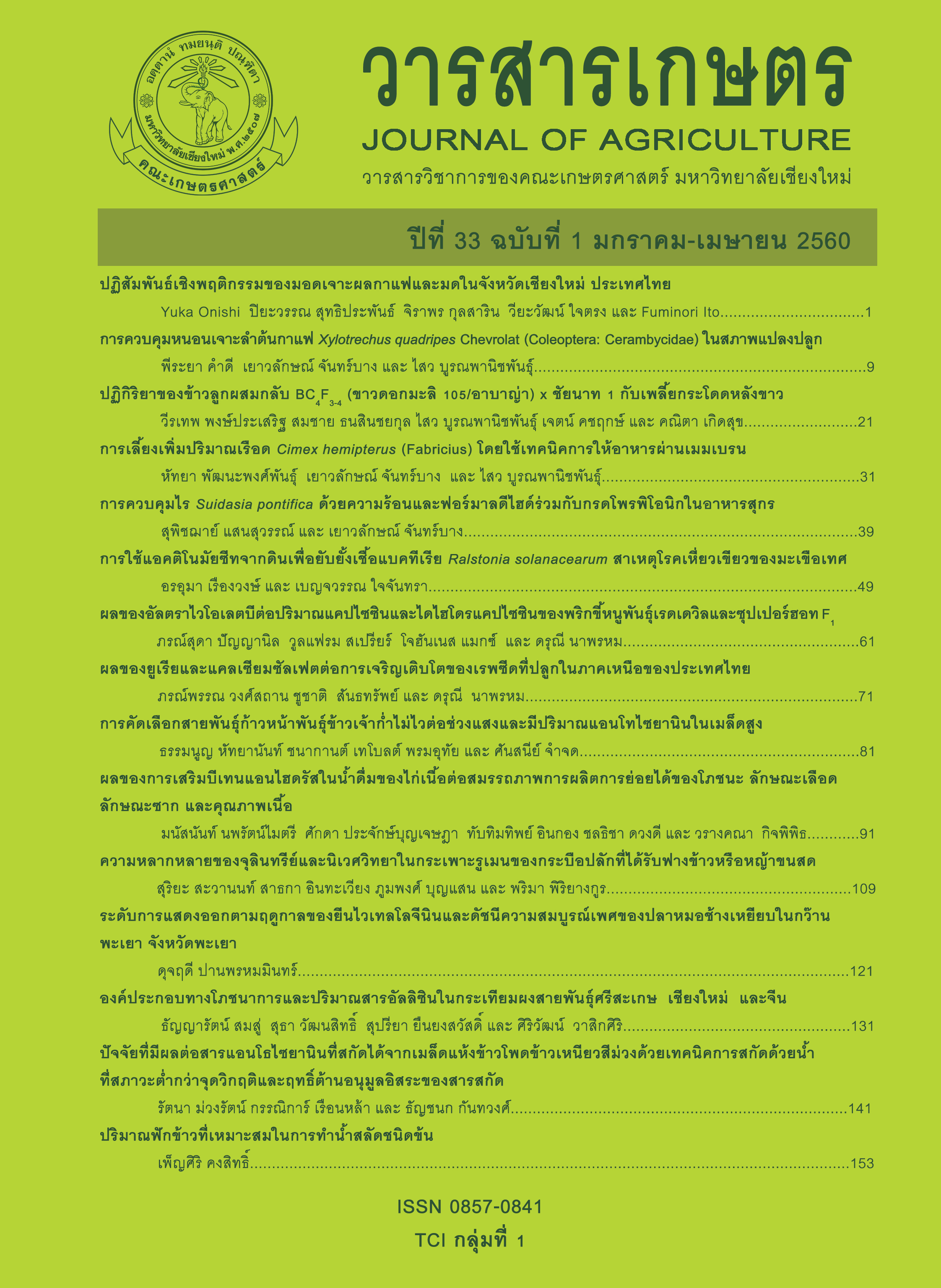Nutritional Compositions and Allicin Content in Garlic Powder Si Sa Ket, Chiang Mai and Chinese Garlic Cultivars
Main Article Content
Abstract
The aim of this study is to determine nutritional compositions and allicin concentration of dried garlic powder produced from Si Sa Ket, Chiang Mai and Chinese garlic cultivars. The action of allicin help to inhibit Salmonella Typhimurium growth and this research can use a basic data for apply in animals. The results found that Chiang Mai dried garlic powder had the highest (P<0.05) nutritional compositions (90.75 ± 0.03% dry matter, 26.86 ± 0.09% crude protein, 0.94 ± 0.19% crude fat, 4.62 ± 0.03% crude fiber and 3.89 ± 0.04% ash). Chinese dried garlic powder had the highest nitrogen free extract at 63.39 ± 0.33% (P<0.05). Allicin concentration of Chinese dried garlic powder was 7.27 ± 0.55 mg per gram and significantly higher than those of Si Sa Ket dried garlic powder (3.68 ± 0.06 mg per gram) and Chiang Mai dried garlic powder (4.82 ± 0.02 mg per gram) (P<0.05).
Article Details
References
พิษณุ สุขแก้ว. 2555. ผลของธาตุอาหาร อายุเก็บเกี่ยวและสภาพการเก็บรักษาต่อปริมาณอัลลิซินในกระเทียม (Allium sativum L.). วิทยานิพนธ์วิทยาศาสตรมหาบัณฑิต. มหาวิทยาลัยเทคโนโลยีสุรนารี, นครราชสีมา. 72 หน้า.
มนัสนันท์ นพรัตน์ไมตรี วรางคณา กิจพิพิธ ชวลิต ผึ้งปฐมภรณ์ ศราวุธ ม่วงเผือก เอกกมล กมลลาภวรกุล นาฏยา แบ่งลาภ และ เสาวภา เขียนงาม. 2558. ผลของการเสริมซินไบโอติกส์ ต่อสมรรถภาพการผลิตไก่เนื้อและผลตอบแทนทางเศรษฐกิจ. วารสารเกษตร 31(3): 349-366.
สำนักงานเศรษฐกิจการเกษตร. 2558. สถานการณ์สินค้าการเกษตรที่สำคัญและแนวโน้มปี 2558. (ระบบออนไลน์). แหล่งข้อมูล: www.foodfti.com/Files/Name/CONTENT1257713626911.pdf (19 สิงหาคม 2558).
อัจฉรา นิยมเดชา. 2559. การใช้กรดอินทรีย์ต่อการยับยั้งการเจริญของแบคทีเรียกลุ่มก่อโรค (ซัลโมเนลล่า) ในทางเดินอาหารของสัตว์ปีก. วารสารเกษตร 32(1): 139-149.
Ankri, S. and D. Mirelman. 1999. Antimicrobial properties of allicin from garlic. Microbes Infect. 2: 125-129.
AOAC. 1990. Official Methods of Analysis. 15th ed. AOAC International, Washington, D.C. 771 p.
Curtis, H., U. Noll, J. Stormann and A. J. Slusarenko. 2004. Broad-spectrum activity of the volatile phytoanticipin allicin in extracts of garlic (Allium sativum L.) against plant pathogenic bacteria, fungi and Oomycetes. Physiological and Molecular Plant Pathology 65: 79-89.
Farias-Campomanes, A.M., C.N. Horita, M.A.R. Pollonio and M.A.A. Meireles. 2014. Allicin-rich extract obtained from garlic by pressurized liquid extraction: quantitative determination of allicin in garlic samples. Food and Public Health 4: 272-278.
Feldberg, R.S., S.C. Chang, A.N. Kotik, M. Nadler, Z. Neuwirth, D.C. Sundstrom and N.H. Thompson. 1988. In vitro mechanism of inhibition of bacterial cell growth by allicin. Antimicrobial Agents and Chemotherapy 32: 1763-1768.
Khajarern, S., B. Sripanidkulchai, J. Khajarern and S. Phoungchandang. 2005. Development of garlic (Allium sativum Linn.) as an antimicrobial substance and feed additive for poultry and pig industries. Final report. Khon Kaen University, Khon Kaen. 55 p.
Maron, D. F., T. J. S. Smith and K. E. Nachman. 2013. Restrictions on antimicrobial use in food animal production: an international regulatory and economic survey. Global Health 9: 1-11.
National Sanitation Foundation. 2005. Determination of allicin in garlic by high-performance liquid chromatography. Allicin by high-performance liquid chromatography (INA method 110.001). (Online). Available: http://www.nature4science.com/Garlic/HTMLs/allicin_testing_method.html (December 8, 2015).
Office of the British Pharmacopoeia. 2009. British Pharmacopoeia. The stationery Office, London. 10952 p.
Okolo, S.C., O.O. Olajide, D.I. Idowu, A.B. Adebiyi, P.P. Ikokoh and A.T. Orishadipe. 2012. Comparative proximate studies on some Nigerian food supplements. Annals of Biological Research 3: 773-779.
Oluwatoyin, A. 2014. Physicochemical characterisation, and antioxidant properties of the seeds and oils of ginger (Zingiber officinale) and garlic (Allium sativum). Chemical Science 2: 44-50.
Saenkhunthow, U. 2002. Processing methods of garlic (Allium sativum Linn.) as powdered herbal feed additive and the effects of its supplementation in diets on performance, disease control and carcass quality of broilers. M.S. Thesis Khon Kaen University, Khon Kaen. 107 p.
Steel, R.G.D. and J.H. Torrie. 1980. Principles and Procedures of Statistics: A Biometrics Approach. 2nd ed. McGraw-Hill, New York. 633 p.
Sultan, M.T., A.N. Ahmad, M.S. Saddique, M.Aghazadeh, M. Imran, M.M.N. Qayyum and M.S. Abbas. 2014. Antioxidant and antimicrobial potential of locally sun dried garlic and ginger powder available in district Layyah, Punjab, Pakistan. Pakistan Journal of Nutrition 13: 642-647.
Yabaya, A., A. Orukotan and M. Jonathan 2010. Determination of anti Salmonella typhi activity of the crude extract of Allium sativum (garlic). Journal of Biological Sciences and Bioconservation 2: 22-28.
Zhou, C., X. Hu, C. Chao, H. Li, S. Zhang, X. Yan, F. Yang and Q. Li. 2015. Quantitation of allicin in garlic-based products: comparisons among spectrophotometry, GC and HPLC. Adv. Journal of Food Science and Technology 9: 269-277.

